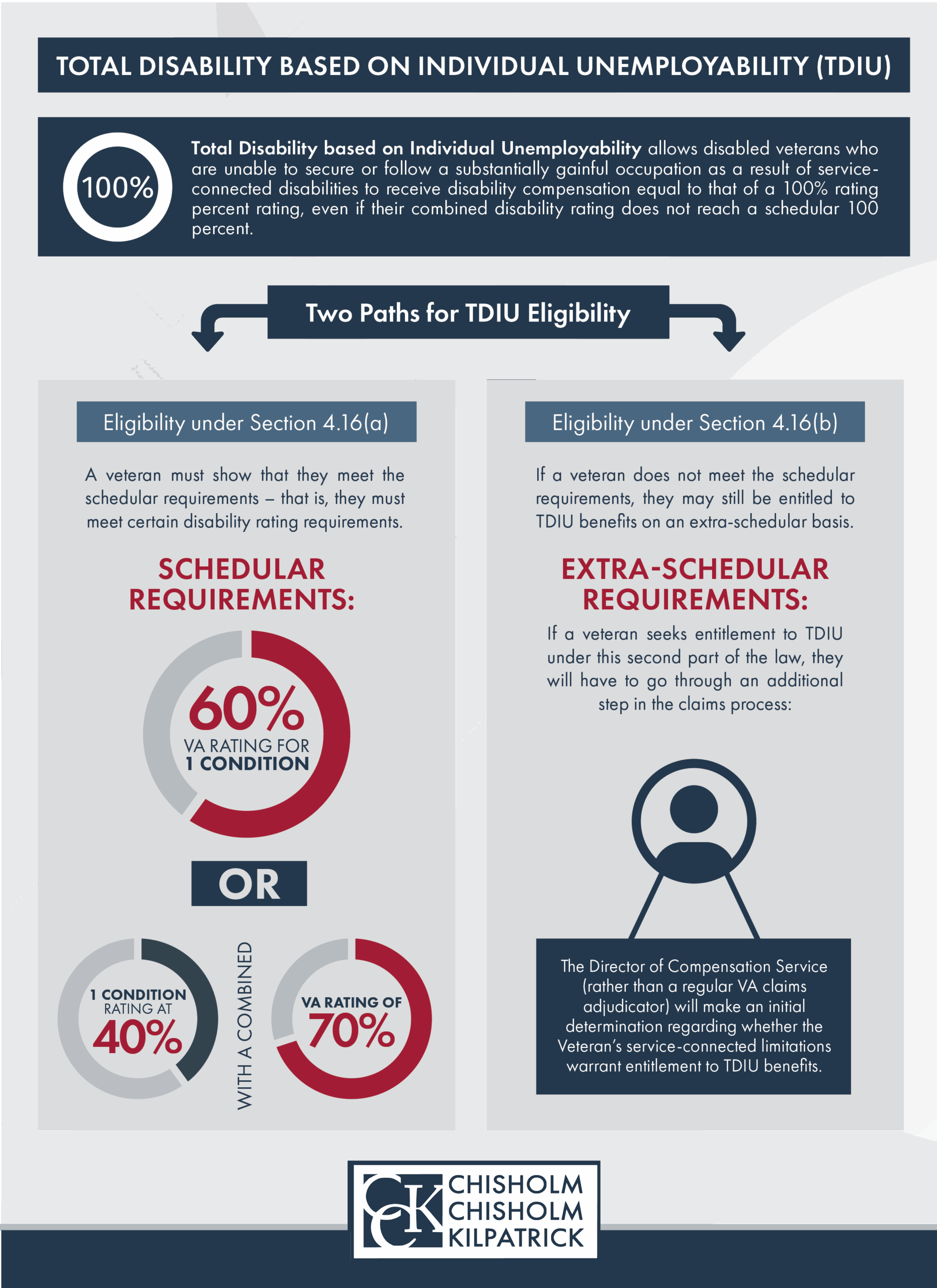How to Increase a VA Disability Rating from 80% to 100%

CCK Law: Our Vital Role in Veterans Law
The difference between an 80 percent rating and a 100 percent rating can be significant, both in compensation and in other benefits. Many benefits are exclusive to veterans rated at 100 percent, who the Department of Veterans Affairs (VA) considers totally disabled in the sense of earning potential.
As of 2025, veterans with an 80 percent rating receive $2,044.89 in monthly compensation. Veterans who are rated at the 100 percent disability rating level receive $3,831.30. That means that veterans who are rated at 100 percent receive $1,786.41 more per month compared to those rated at 80 percent.
However, monthly compensation is only one of the factors to consider. Many additional VA and state veteran benefits are only available to veterans with total disability status. If you are a disabled veteran with an 80 percent rating but feel that you are eligible for an increase to 100 percent VA disability, then this article will guide you through the ins and outs of the process.
Highlights of this article include:
- Various strategies on how to go from 80 to 100 percent VA disability
- How to appeal VA’s decisions and increase your rating
- What evidence is strongest for demonstrating eligibility for a higher rate of compensation
- Tips for applying for Total Disability based on Individual Unemployability (TDIU)
- And more

Option 1: File an Appeal
If you disagree with a rating decision VA has made and you meet the timing requirements, you can file an appeal to get VA to change your rating, potentially getting you closer to a 100 percent rating.
Under the Appeals Modernization Act (AMA), you have one year from the date that VA notified you of a rating decision to choose one of the following three appeal options:
- Higher-level Review Lane: This lane involves the veteran asking that their disability claim be judged by a more experienced VA rating specialist.
- Supplemental Claim Lane: This lane involves the veteran submitting new and relevant evidence to get VA to re-evaluate their claim.
- Notice of Disagreement Lane: This lane involves the veteran appealing to the Board of Veterans’ Appeals to judge their case.
Option 2: File an Increased Rating Claim
Under certain circumstances, VA may increase your disability rating in light of new evidence that your condition has worsened. If you think your service-connected condition warrants a higher disability rating than the one it is currently assigned, you have the right to file a new claim for an increased rating.
To demonstrate eligibility for an increased rating, veterans should consult VA’s rating criteria for their conditions. Veterans can read through the rating criteria and determine how their symptomology lines up with what is listed. They can then submit the following types of evidence to support their increased rating claims and appeals:
- In-Service Medical Records: These records include enlistment and separation examinations, as well as any hospital stays or sick calls during service.
- Private Medical Records: To obtain these records, veterans can typically request them directly from their private provider. If a veteran notifies VA that they are treating with a private provider and signs a release form, VA can request records directly from the provider to obtain the veteran’s medical records.
- VA Medical Records: VA can obtain these records directly from the VA medical center(s) where the veteran receives treatment. If a veteran wants to obtain these records themselves, they can request them directly from the VA medical center as well.
- C&P Examinations: In many cases, VA will schedule a veteran for a C&P exam to assess the merits of service connection or an increased rating for the veteran’s condition. If favorable, these examinations can be useful in substantiating a claim.
- Medical Opinions: Veterans can request a medical opinion from their treating doctor to help substantiate their claim. Medical opinions can come in handy if the veteran had an unfavorable C&P examination and wants to argue against the examiner’s findings.
- Lay Statements: A lay statement is a written statement from a veteran, family member, friend, or co-worker outlining the onset and progression of the veteran’s condition. Statements can be submitted directly to VA.
Option 3: File a Claim for Secondary Service-Connected Condition(s)
File a Claim for a Secondary Service-Connected Condition
Many veterans are not aware that chronic (long-term) medical conditions caused by a service-connected condition are also eligible for compensation.
A condition is secondary service connected when it has been caused by a primary condition that is service connected.
For instance, a veteran may receive a disability rating for tinnitus that VA has determined was caused by an explosion during their military service. If this tinnitus then goes on to cause insomnia for the veteran, then that insomnia would be characterized as secondary service connected, since it was brought on by a primary service-connected condition, the tinnitus.
In a case like this, the veteran would be able to file a disability claim for their insomnia and potentially receive a higher combined VA rating, getting them ever closer to total disability.

Option 4: Apply for Total Disability Based on Individual Unemployability (TDIU)
Because of the way in which VA adds disabilities together, it is difficult to go from a schedular 80 percent to a schedular 100 percent rating. You would need to have another condition rated at 80 percent to receive a 100 percent combined schedular rating. Alternatively, you would need to have multiple additional conditions that equaled another 80 percent rating.
Some veterans may therefore find the easiest path to the 100 percent rating through TDIU, or total disability based on individual unemployability.
TDIU is a monthly benefit that pays veterans at the 100 percent rating level, even if their combined disability rating is less than that. In this way, it is an alternative path to receiving maximum benefits.

“TDIU requires you to show that your service-connected disabilities prevent you from gaining and maintaining substantially gainful employment,” says Michael Lostritto, Managing Attorney at CCK Law. “It allows veterans to be compensated at the 100 percent level, despite the fact that they’re otherwise not combined at the 100 percent rate.”
VA outlines two ways in which veterans can pursue TDIU: schedular and extraschedular.
To qualify for TDIU under 38 CFR § 4.16(a), or schedular TDIU, a veteran must have:
- One service-connected condition rated at 60 percent or higher; or
- Two or more service-connected conditions, one of which is rated at 40 percent or higher, with a combined rating of 70 percent or higher.
Veterans who do not meet the schedular requirements under 38 CFR § 4.16(a) may still be considered for extraschedular TDIU under § 4.16(b).

Need Help Increasing an 80 Percent VA Rating to a 100 Percent Rating?
With an experienced, VA-accredited veterans’ attorney at your side, you will have the best chance of increasing your 80 percent VA rating to 100 percent and gaining the benefits you deserve.
Chisholm Chisholm & Kilpatrick has helped many veterans win their appeals, increased rating claims, and TDIU applications. Call our office at (800) 544-9144 or contact us online for a free case evaluation!
About the Author
Share this Post

